I was back on track for my third try, this time in mid-December, well past the November rutting season when the large rams suddenly appear out of the hills looking for mates. The rut is typically the best time for a large and mature ram to be spotted, but in mid-December, one could still find some of the rams hanging out with the ewes. My Iranian passport had expired and had to be renewed in Washington, DC. I bought my ticket, but my passport didn’t arrive until the day before I was to fly out — a cliff-hanger. Then to make things more interesting, I received a call from Mr. Mostofi. He was concerned because he was not able to find ammunition for the rifle we would be taking on this hunt. We were to use an Austrian made Furloch rifle in 270 Winchester. Trustworthy ammunition couldn’t be found due to the economic embargo, which had made it challenging to import sporting goods and supplies into Iran. He finally located a box, and I was thankful for it.
On arrival in Iran, I spent a day in Tehran, then headed, again, to Mashhad. My stay there was short this time, but the morning before our departure, I woke up in a panic and feeling trapped. My fear was that things would go wrong, and I would have to go back home, empty-handed for the third time. Then I remembered the saying, “you are going to think anyway so you might as well think positive.” All would go right this time. We headed to our destination with a new driver, but Ali and Teymour were with us once again. On the way to the mountains, we reminisced about our last adventure. We drove west towards the city of Quchan, then south towards Neyshabur, the resting place of the famous Persian mathematician and poet Omar Khayyam, and where some of the best quality Turquoise in the world is mined. Halfway between the two small cities was the village of Chenar. The primary route to our hunting ground.
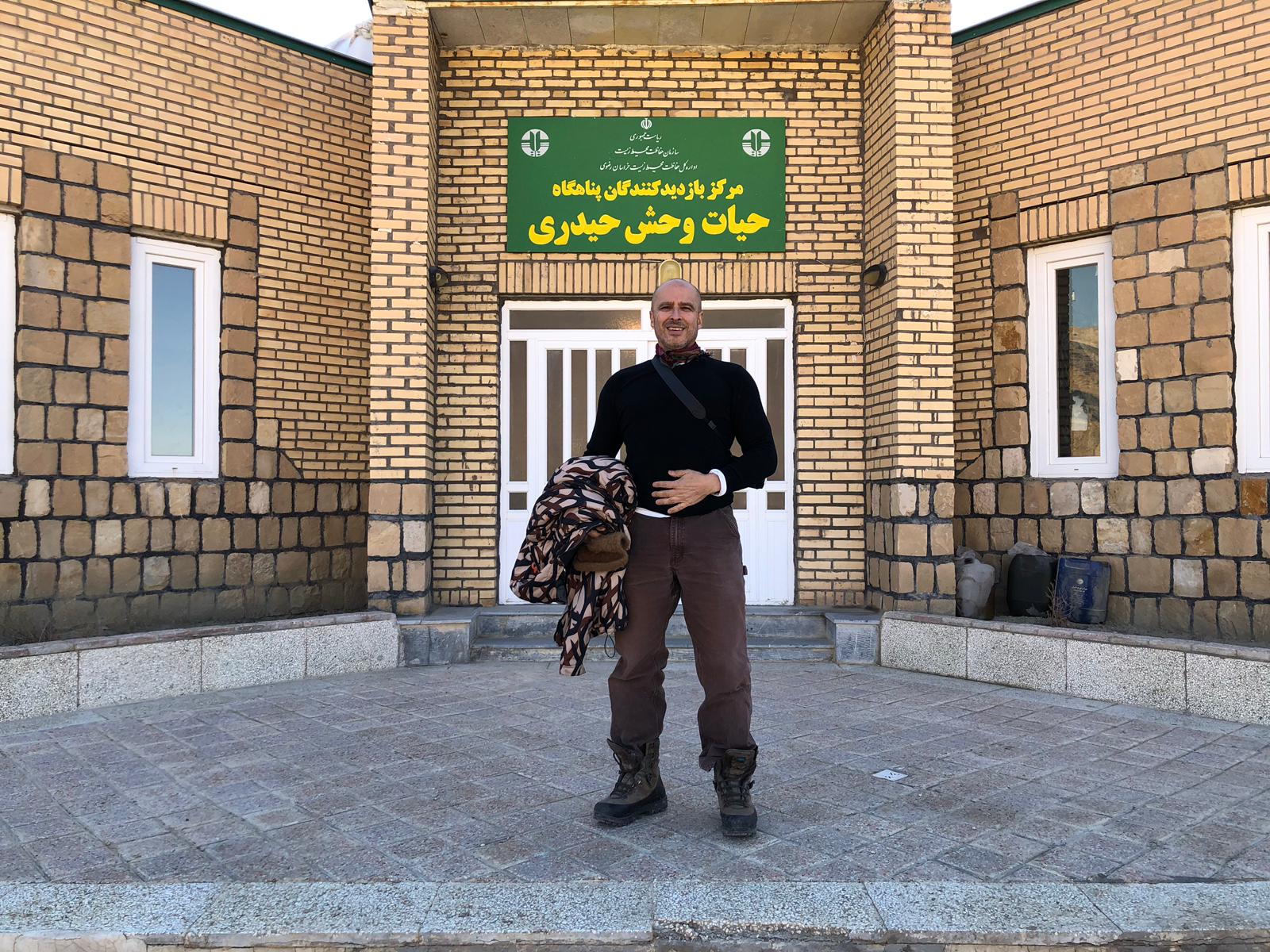
I was excited to no end to be back on my third try for a trophy Urial ram.
We spent the night at the entrance to the valley below our hunt area at a modern house made for international guests. The large rooms with a modern kitchen were a far cry from the little mud hut where we spent the night in the previous hunt. The head warden for this area, Mr. Ardalan, lived in a nearby village but had come to greet us the afternoon we reached the guest house. He was a short and thin man in his 40’s with a neatly trimmed beard and piercing black eyes. He spoke with the Kurdish accent common in that region. According to him, when he took over the management of the area, there were only 600 Urials in the mountain range under his jurisdiction. But in just a few years, he had increased the number to over 2600 heads by strictly enforcing the laws and getting rid of poachers. He seemed proud of his accomplishment, and I admired him for his success, as this is not an easy task. After presenting our permit, we headed to the guest house to review our plan for the next day.
The next morning we were up for breakfast at 4 am, standard sheep hunting time. Mr. Ardalan had agreed to guide me on this hunt personally. He was the whole package. A great hunter on his account, he knew every nook and cranny of those mountains — he was born in a nearby village and had lived there all his life, and he could outwalk all of us. He met us at our lodge on time wearing a military-style jungle green jacket, what seemed to be a woman’s light purple sweatpants due to his small size, and a World War II-style pilot’s hat with the flaps pulled down over his ears, with the final touch of a Kalashnikov on his shoulder. It was a very unusual sheep hunting outfit, but I did not doubt his ability as a hunter and guide.

A striking picture of a Urial skull at dusk. Wolves take a big toll on these magnificent sheep.
By going around and up the road near the village of Kalidar, we drove to the highest point we could get to in the snow. It was bitterly cold and sunny as we left the SUV and began our hike to the summit. Teymour and Ali, my friends from the last hunt, were ahead of me following Mr. Ardalan and his young assistant Esfandiar. I was still jet-lagged but kept up with them up the hill. At the summit, which was a little over 7500 ft, we began glassing and immediately saw sheep everywhere. Almost every valley and small canyon had sheep in it. Small bands here and there, a sight one might only see in a dream. The scattered bands made it difficult to approach, but we navigated our way without losing elevation. The plan was to stay on top of the ridge and (look into) glass the valleys below.
The terrain here resembled the Owyhee’s of southwest Idaho, with the dominant vegetation being a plant locally called Gavan, a favorite food for Urials year-round. Several times we ran into single ewes acting as sentinels above the herd, keeping a sharp watch over the valley below. Once the sentinel was spooked, the bands quickly would disappear below or ahead of us. Around two o’clock, we made the traditional but welcome break for tea, then headed up to the next ridge. As we began glassing, a very large herd of Urials were spotted about 1000 yards below us. There were at least 200 sheep in this group with approximately 80 rams in the bunch and 15 excellent rams leading the party towards a canyon ahead.
There was no way to get close to this group, so we waited until the last disappeared into the canyon out of our view. We followed them as fast as we could, hoping to get to the edge of the canyon for a shot at one of the large rams. We were hoping we would be able to see the rams as they climbed out on the other side for an easy 150-yard shot. When we got to the edge, however, all we could see was their tracks in the snow and droppings — “peshgels” in Farsi.
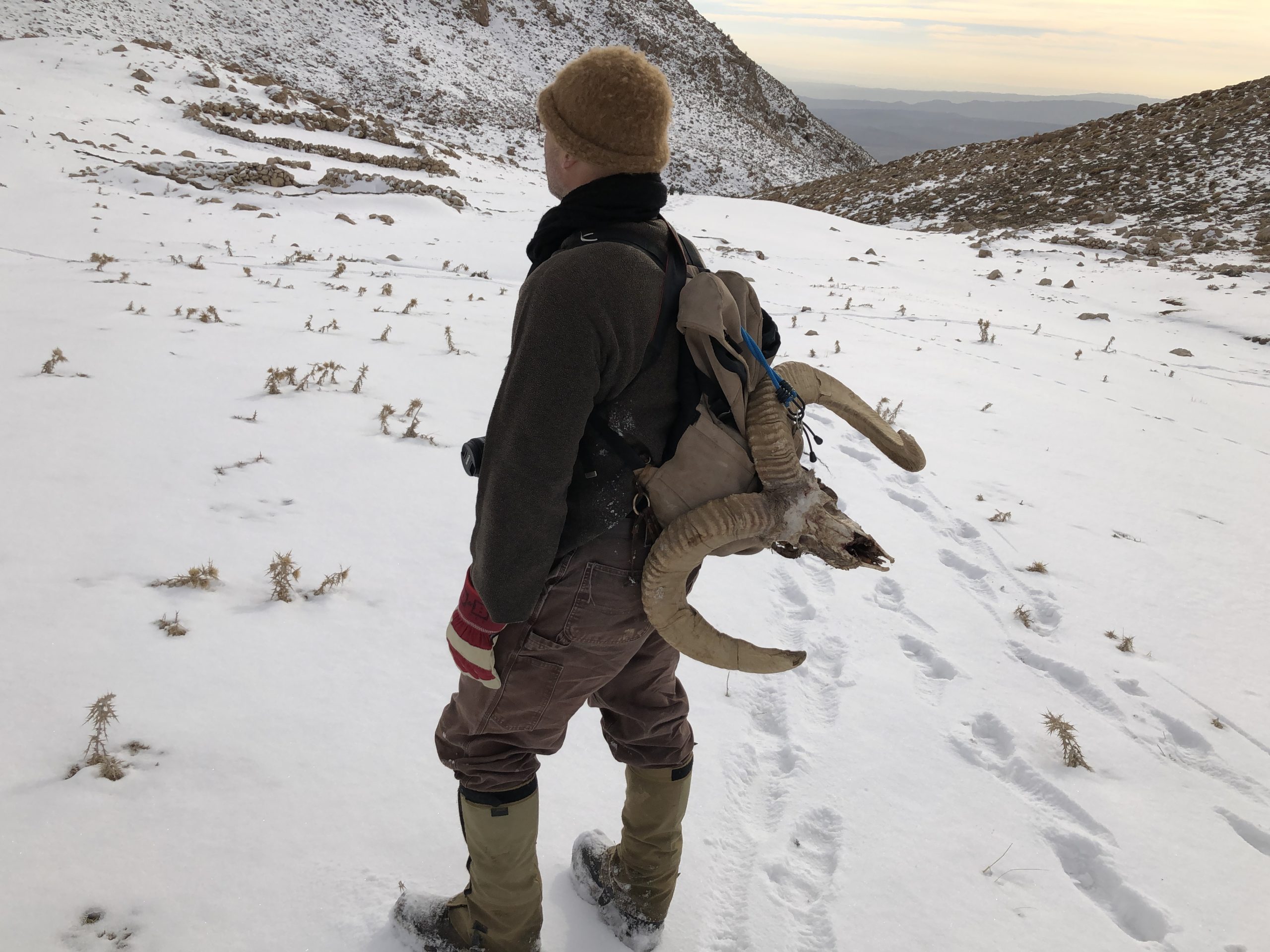
A horned skull that I found and carried back to camp.
Instead of crossing to the opposite side, they had headed down into the lower canyon below and were now too far for a shot and too fast to catch up to. Mr. Ardalan suggested we call it a day and come back tomorrow. I asked him if we could cover one more ridge and look into the next valley before we head back. He stared at me for a few seconds and said, “We normally don’t take any of our foreign hunters beyond this last valley, but since you are an Iranian, I will make an exception.” He led the way up the hill. That comment made me both happy and nervous. He was opening his off-limits area for which I was grateful. We headed up a steep rock face into the next valley walking in a single line with me at the end of the line.
Suddenly, I saw Mr. Ardalan, Ali, and Teymour all drop to their knees and motioned for me to crouch down and get to where they were. They had seen a ram! Mr. Ardalan whispered in my ear, “This is a great ram.” Carefully, I peeked over a rock and saw a gorgeous full curl ram and five ewes feeding about 300 yards away across a small canyon. We were peeking across from behind a knoll with only my hat and eyes exposed to the sheep. “I see him, feeding,” I said. Mr. Ardalan whispered, “Not that one. Shoot the one lying down.” I tried to see what he was talking about but couldn’t see any rams lying down. He kept trying to pinpoint the location of the ram, but I couldn’t see him.
Despite being very careful not to move too much and only whispering, suddenly, the standing ram and all the ewes simultaneously looked straight in our direction. A moment later, from behind the standing ram, I saw the resting ram jump to his four legs. From my location, the standing ram had obstructed my view. At a glimpse, that second ram seemed much wider than any ram I had seen, but Urials don’t give you a chance to analyze them. Suddenly, the rams and ewes bolted at full speed and headed up the hill. Mr. Ardalan was now excited and kept repeating to me, “Hurry, that’s a great ram, hurry, shoot, he is going over the ridge.”
Amazingly, I was calm. I had rehearsed this moment for years in my mind’s eye. As I found the big ram in my Zeiss scope, I was in awe of the shape of his horns. They seemed extra wide and thick at the base. The bullets I had brought with me had been hand loaded properly. I had tested the gun at 200 yards and was familiar with the bullet’s trajectory at longer distances. As the big ram bolted, I kept the crosshairs on his shoulder. He was moving fast towards the opposite ridge when, for what felt like a fraction of a second, he hesitated to jump up on a tall boulder. The distance was approximately 350 yards. I aimed slightly high at the junction of shoulder and neck, and with the sound of the gun, the ram dropped in his tracks. Time slowed at that moment — I felt a sense of calm and relief. The two wardens, Ali and Teymour, were beside themselves, hollering and screaming in joy. Each of them ran up to me, still in the prone position after the shot, and kissed my face on the right and left side, the traditional congratulating gesture.
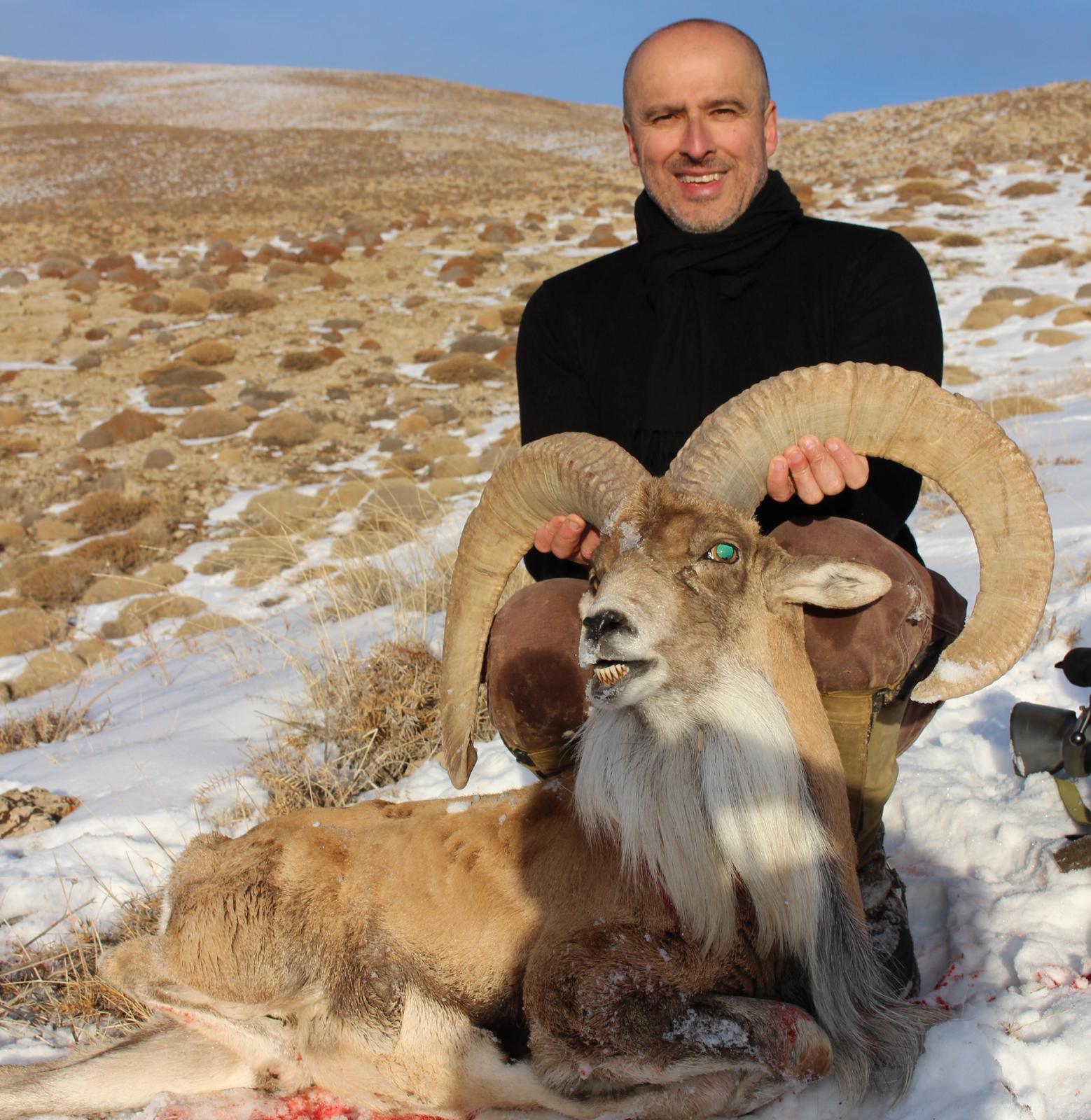
I was on cloud nine when I held my ram for the first time.
As we approached him, I could see the ram was wide but guessed his horns to be around a respectable 85 centimeters (33.5 inches). I was still in disbelief. Mr. Ardalan kept repeating “Alieh, Alieh,” meaning it’s a great one. I couldn’t disagree. Any old ram here was a trophy of a lifetime if one is lucky to find it in three days. We had accomplished it on our first day, after a 9.5-hour climb. But first, I had to wait 40 years, make three attempts, fly thousands of miles and hike a couple of hundred miles to find him on day one! As the old saying goes, “things happen in an instant if you are willing to wait.” Picture-taking ceremony over, Ali emptied the guts, leaving everything above the diaphragm in the ram and picked the entire ram up and put it on his shoulder, carrying it down the mountain walking very fast. It is considered an honor to do so, even though it is an extremely difficult task. A mature Urial ram can weigh up to 150 pounds. But Ali was an expert and down he went leaving us all behind. The sun was beginning to set as we hiked down the mountain towards where the SUV was to meet us. The sky was brilliant orange, and I could see for hundreds of miles into this ancient and beautiful region of the world which most people will not get a chance to see.
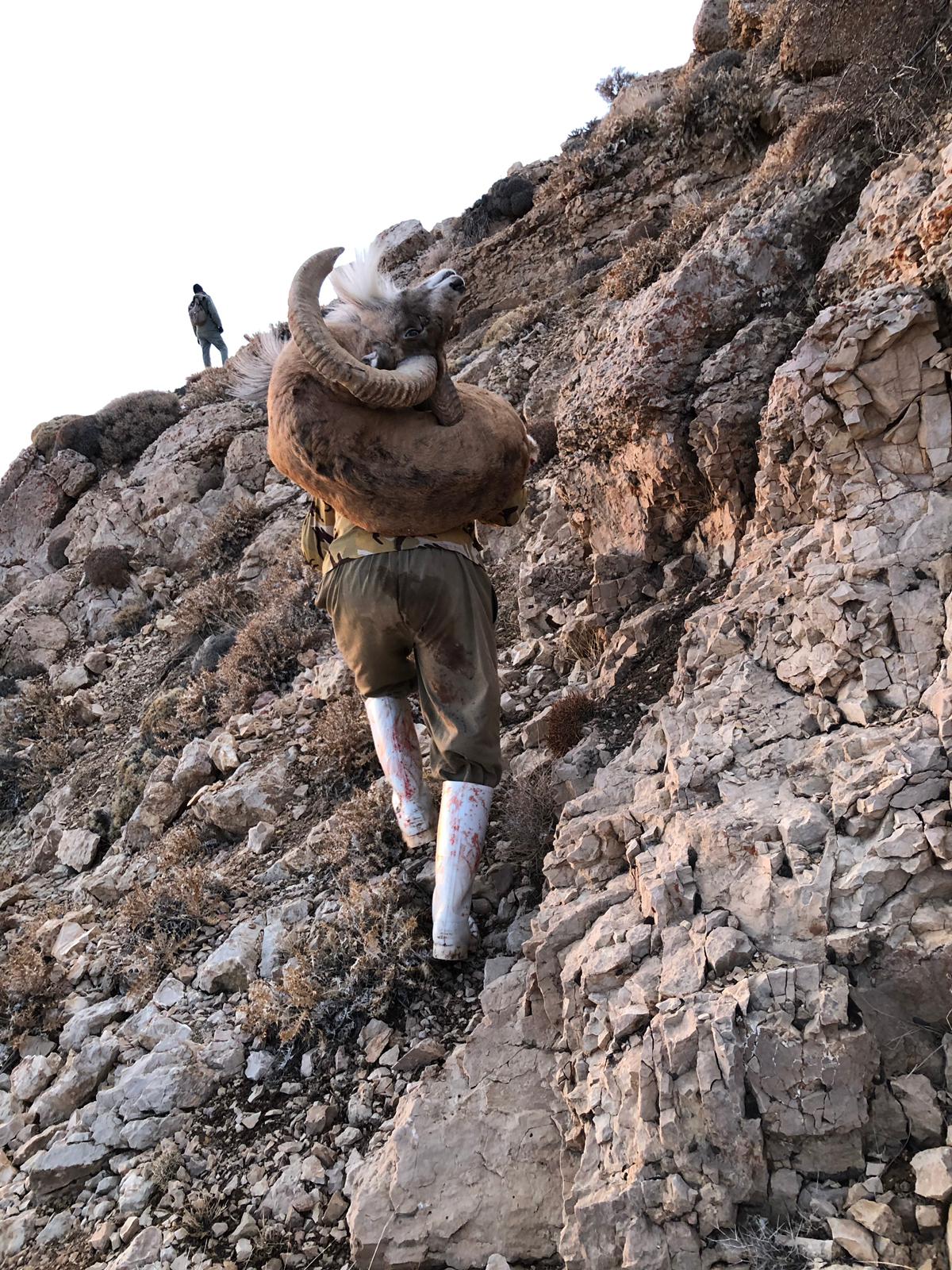
My guide Ali carrying my ram single-handedly back to camp. Guys like him are the true sheep hunters of the world!
As I walked behind Ali with the ram on his back, I couldn’t resist touching his skin and horns and thanking him for giving his life, only to bring my dreams into reality. Our vehicle was waiting for us, and we reached it just before dark. The men had built a large fire keeping themselves warm as they waited for us. The assistant head warden, upon seeing my ram, immediately said, “This is a record ram!” I thought he was being nice, but back at the lodge, the wardens conducted their biometrics. The right horn was 97 centimeters (38 inches); the left had broken off down to 95 centimeters (37.5 inches). Diameter at the base was 29 centimeters (11.5 inches), and the distance from the widest part of the horns to the opposite side an incredible 77 centimeters (30 inches), the widest width on a Transcaspian Urial recorded to date.
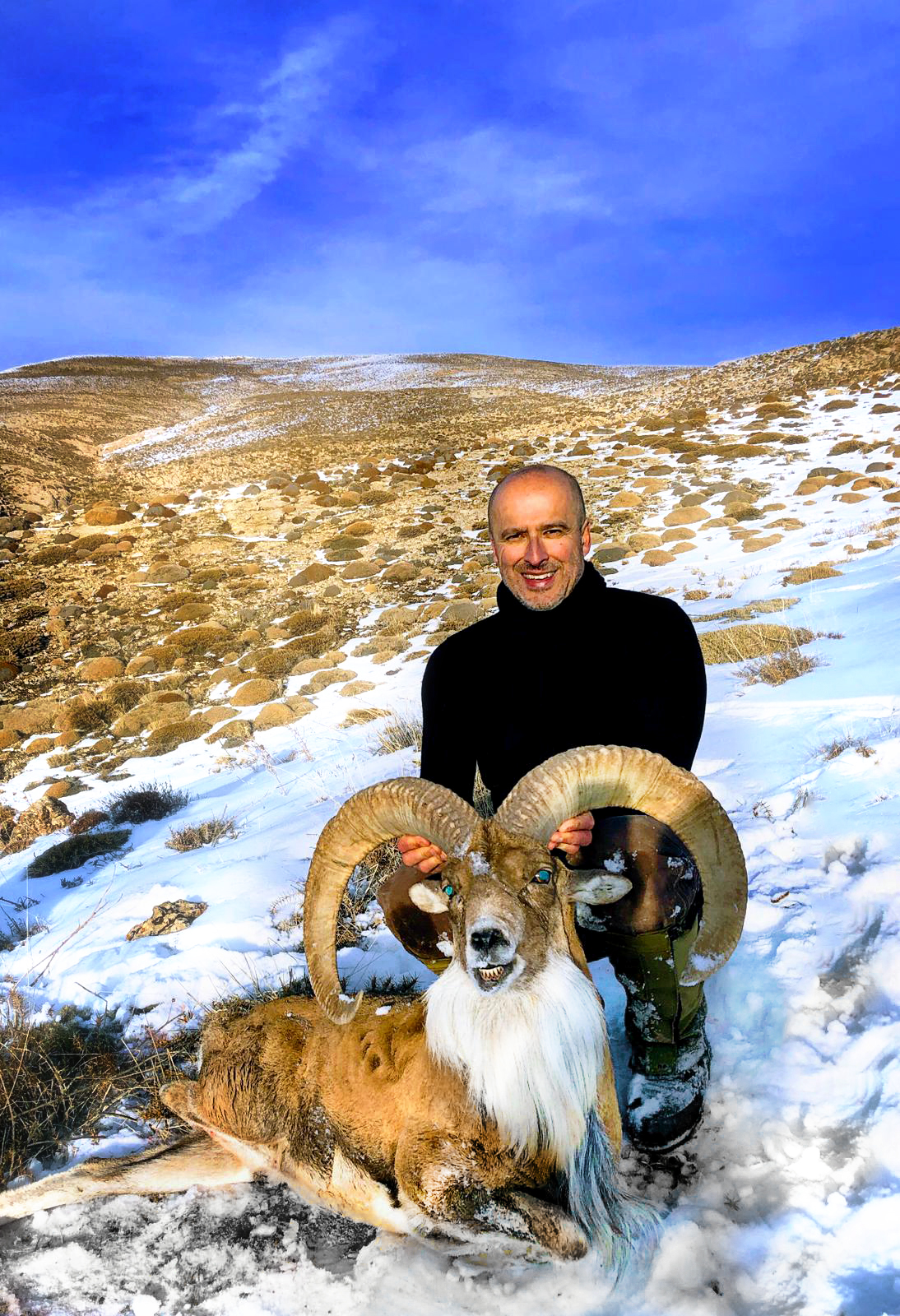
All these years of dreaming, trying and planning had finally paid off.
The previous record was 74 centimeters (29 inches), according to the Iranian Department of Environment. Boone and Crockett measurement of rams for North America does not record width as part of scoring sheep horns, but in Europe and Asia, the standard for measurement is based on a different system in which the width measurement is as important as the length and necessary for the final score. The reason the ram had looked smaller to me initially was due to the horns expanding outwards instead of curling in tightly. He was a 10-year-old, gold medal ram with a few teeth missing but weighed 165 pounds! A fat old healthy ram. I was thankful to everyone in our team, especially Mr. Mostofi, for working so hard to organize all three hunts. I was especially thankful, too, to my late friend Nouri who had made this all possible. He would have definitely upgraded my status to something above “Shikarchieh Bozorg.”
As we left the lodge, I remembered that I had also seen a picture of huge Bezoar Ibex in the old hunting magazine, but that would have to await my return on another occasion to The Land of the Lion and the Sun.

